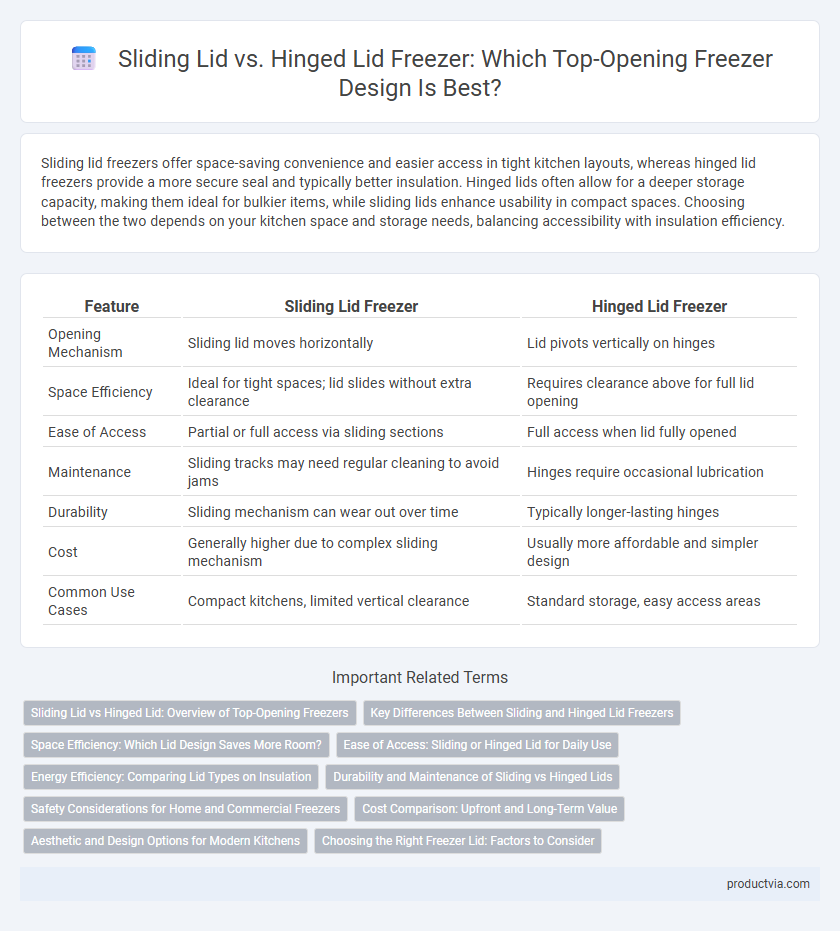Sliding lid freezers offer space-saving convenience and easier access in tight kitchen layouts, whereas hinged lid freezers provide a more secure seal and typically better insulation. Hinged lids often allow for a deeper storage capacity, making them ideal for bulkier items, while sliding lids enhance usability in compact spaces. Choosing between the two depends on your kitchen space and storage needs, balancing accessibility with insulation efficiency.
Table of Comparison
| Feature | Sliding Lid Freezer | Hinged Lid Freezer |
|---|---|---|
| Opening Mechanism | Sliding lid moves horizontally | Lid pivots vertically on hinges |
| Space Efficiency | Ideal for tight spaces; lid slides without extra clearance | Requires clearance above for full lid opening |
| Ease of Access | Partial or full access via sliding sections | Full access when lid fully opened |
| Maintenance | Sliding tracks may need regular cleaning to avoid jams | Hinges require occasional lubrication |
| Durability | Sliding mechanism can wear out over time | Typically longer-lasting hinges |
| Cost | Generally higher due to complex sliding mechanism | Usually more affordable and simpler design |
| Common Use Cases | Compact kitchens, limited vertical clearance | Standard storage, easy access areas |
Sliding Lid vs Hinged Lid: Overview of Top-Opening Freezers
Sliding lid freezers offer smoother access in tight spaces by sliding horizontally without requiring extra clearance, making them ideal for compact kitchens. Hinged lid freezers provide a traditional vertical opening with better sealing and often more durable hinges, ensuring long-term insulation efficiency. Choosing between sliding and hinged lids depends on spatial constraints, ease of access, and insulation performance in top-opening freezer designs.
Key Differences Between Sliding and Hinged Lid Freezers
Sliding lid freezers offer space-saving benefits with lids that glide smoothly, making them ideal for tight areas, while hinged lid freezers provide easier full-access opening for larger items due to their vertical lift design. Sliding lids often have fewer mechanical parts, reducing maintenance needs compared to the more complex hinge mechanisms. Temperature retention varies as hinged lids create a tighter seal, enhancing energy efficiency and minimizing frost buildup in top-opening freezers.
Space Efficiency: Which Lid Design Saves More Room?
Sliding lid freezers maximize space efficiency by allowing easy access without requiring additional clearance for lid movement, making them ideal for tight or confined spaces. Hinged lid freezers demand a larger opening radius, which can limit placement options and reduce usable kitchen or storage room. The sliding lid design is preferable for optimizing space in compact environments due to its minimal spatial footprint.
Ease of Access: Sliding or Hinged Lid for Daily Use
Sliding lid freezers offer enhanced ease of access in tight spaces by allowing the lid to slide open without requiring extra clearance, making daily use more convenient in compact kitchens. Hinged lid freezers provide a traditional, wide-opening design that enables quick visibility and retrieval of items but may need more overhead space for full lid rotation. Selecting between sliding and hinged lid freezers depends on available space and user preference for seamless access during frequent freezer use.
Energy Efficiency: Comparing Lid Types on Insulation
Sliding lid freezers often experience more air leakage due to alignment challenges, reducing insulation effectiveness and increasing energy consumption compared to hinged lid freezers. Hinged lid freezers provide a tighter seal with fewer gaps, enhancing thermal retention and lowering energy costs over time. Energy efficiency ratings typically favor hinged lid designs in top-opening freezers because of their superior insulation performance.
Durability and Maintenance of Sliding vs Hinged Lids
Sliding lid freezers offer enhanced durability due to fewer moving parts and reduced hinge wear compared to hinged lid freezers, which are prone to hinge rust and frequent alignment issues. Maintenance for sliding lids is generally simpler since the sliding mechanism requires occasional lubrication and cleaning, whereas hinged lids often need hinge replacement and more frequent sealing checks to prevent air leaks. Overall, sliding lid freezers provide a more reliable, low-maintenance solution for top-opening freezer designs.
Safety Considerations for Home and Commercial Freezers
Sliding lid freezers offer enhanced safety by reducing the risk of accidental lid slamming, making them ideal for busy commercial environments and households with children. Hinged lid freezers typically feature secure locking mechanisms that prevent the lid from closing unexpectedly, important for preventing injuries and maintaining consistent temperature control. Both designs should incorporate safety features like soft-close hinges and robust gaskets to ensure user protection and energy efficiency in home and commercial freezer applications.
Cost Comparison: Upfront and Long-Term Value
Sliding lid freezers generally have a higher upfront cost due to more complex track mechanisms, while hinged lid freezers tend to be more affordable initially with simpler construction. Over time, sliding lid freezers may offer better energy efficiency and durability, reducing long-term operational costs compared to hinged lid models. Consumers prioritizing budget might prefer hinged lid freezers, but those seeking long-term value and convenience often invest in sliding lid designs.
Aesthetic and Design Options for Modern Kitchens
Sliding lid freezers offer sleek, space-saving designs ideal for modern kitchens with limited overhead clearance, featuring minimalist lines that blend seamlessly with contemporary cabinetry. Hinged lid freezers provide a classic, robust look with larger, uninterrupted surface areas suitable for custom finishes, enhancing aesthetic flexibility in high-end kitchen interiors. Both styles integrate advanced materials and finishes, but sliding lids prioritize streamlined functionality while hinged lids accommodate more diverse design customization.
Choosing the Right Freezer Lid: Factors to Consider
Sliding lid freezers offer easier access in tight spaces and reduce the risk of obstructing nearby areas, while hinged lid freezers provide a more secure seal and better insulation, enhancing energy efficiency. Consider factors such as available space, frequency of use, insulation quality, and ease of maintenance when choosing between sliding and hinged lids for top-opening freezers. Prioritizing energy efficiency ratings, available clearance for lid operation, and durability of sealing materials will ensure optimal freezer performance and longevity.
Sliding lid freezer vs hinged lid freezer for top-opening designs Infographic

 productvia.com
productvia.com